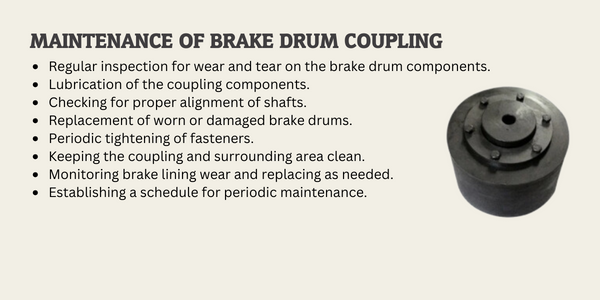Maintenance of Brake Drum Coupling: Ensuring Smooth Operations
Introduction
Brake Drum Coupling is a critical component in various industrial machinery, facilitating the transfer of torque between shafts. Proper maintenance of these couplings is paramount to ensure uninterrupted operations and prevent costly downtimes. In this comprehensive guide, we delve into the intricacies of maintaining Brake Drum Couplings to maximize efficiency and longevity.
Understanding Maintenance of Brake Drum Coupling
Brake Drum Couplings consist of several components, including brake drums, flexible elements, and hubs. These couplings operate based on the principle of friction between the brake drum and flexible elements, allowing for torque transmission while compensating for misalignments. Understanding these components and their functions is crucial for effective maintenance strategies.
Signs of Wear and Tear
Identifying signs of wear and tear is essential for proactive maintenance. Visual inspections for cracks, corrosion, or unusual wear patterns on the brake drums are indicative of potential issues. Additionally, monitoring performance indicators such as increased noise, vibration, or temperature can signal underlying problems requiring attention.
Maintenance Techniques
Regular lubrication of Brake Drum Couplings is vital to reduce friction and prevent premature wear. Tightening of fasteners ensures structural integrity and minimizes the risk of component failure. Periodic inspections allow for the early detection of potential issues, enabling timely interventions to prevent catastrophic failures.
Troubleshooting Common Issues
Misalignment, excessive noise, and vibration are among the common issues encountered with Brake Drum Couplings. Misalignment can lead to uneven wear and compromised performance, necessitating realignment procedures. Excessive noise and vibration may indicate worn-out components or improper installation, requiring thorough inspections and corrective actions.
Importance of Professional Maintenance
While basic maintenance tasks can be performed in-house, engaging professional services for comprehensive maintenance offers numerous benefits. Experienced technicians possess the expertise to identify underlying issues accurately and implement appropriate solutions. Neglecting professional maintenance can result in costly repairs and unplanned downtime, adversely impacting productivity.
Conclusion
Effective maintenance of Brake Drum Couplings is essential for ensuring the smooth and reliable operation of industrial machinery. By adhering to proactive maintenance practices and promptly addressing emerging issues, businesses can enhance operational efficiency, minimize downtime, and prolong the lifespan of critical components.
- Common signs of brake drum coupling failure include visual indicators such as cracks or corrosion on the brake drums, unusual wear patterns, increased noise during operation, excessive vibration, and elevated temperatures. Any deviation from normal operating conditions should prompt a thorough inspection to identify potential issues.
- Brake drum couplings should undergo regular inspections as part of a proactive maintenance regimen. The frequency of inspections may vary depending on factors such as operating conditions, environmental factors, and the manufacturer's recommendations. Typically, it's advisable to conduct visual inspections during routine maintenance intervals and to monitor performance indicators continuously.
- Basic maintenance tasks such as visual inspections and lubrication can often be performed in-house by trained personnel. However, for more complex maintenance procedures or troubleshooting issues, it's recommended to engage the services of experienced technicians or professionals familiar with brake drum coupling systems. Attempting complex maintenance tasks without adequate expertise can potentially exacerbate problems or lead to safety risks.
- The lifespan of a brake drum coupling can vary depending on several factors, including the quality of materials, operating conditions, maintenance practices, and workload. Generally, well-maintained brake drum couplings can last for several years before requiring replacement. Regular inspections, timely maintenance, and adherence to recommended operating parameters can help extend the lifespan of these components.
- Preventing premature wear of brake drum couplings involves implementing proactive maintenance practices and adhering to manufacturer guidelines. Key preventive measures include regular lubrication to reduce friction, routine inspections to detect early signs of wear or damage, ensuring proper alignment of shafts to minimize stress on the coupling, and avoiding overloading or operating machinery beyond its design limits.
- Yes, there are specific lubricants recommended for brake drum couplings to ensure optimal performance and longevity. These lubricants are specially formulated to withstand the operating conditions and requirements of brake drum coupling systems. It's essential to use lubricants recommended by the coupling manufacturer and to follow proper lubrication procedures to maintain peak performance and prevent premature wear or damage.






